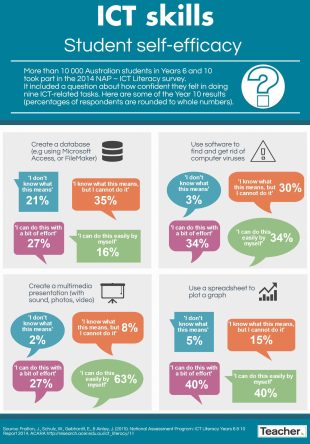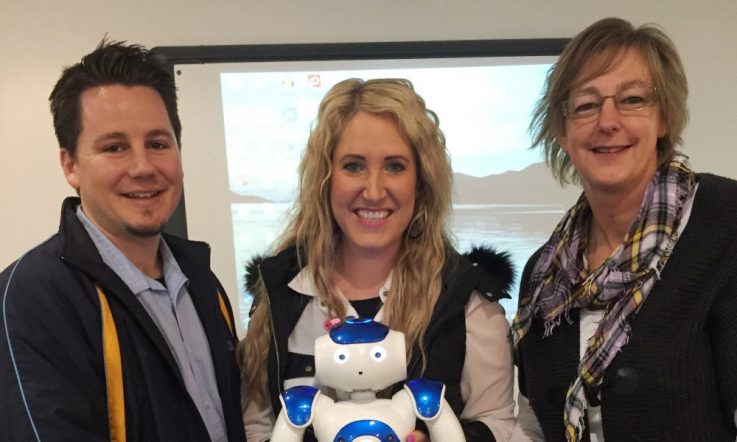In a recent Teacher article, we reported on new data from a triennial assessment of the ICT literacy of students in Australian schools. Here we explore what the results mean by taking a look at some of the activities students at different achievement levels should be able to confidently complete.
The NAP-ICT (National Assessment Program – Information Communication Technology) Literacy Assessment involves students in Year 6 and Year 10. Results from the 2017 test cycle showed there has been little improvement since 2014, and that females significantly outperformed males.
The scoring scale has six designated levels, labelled by ACARA as achievement levels. Another indicator – called the ‘proficient standard' – is also identified for Year 6 and Year 10. ‘The proficient standards in NAP-ICT Literacy were established as a result of consultations with ICT experts and representatives from all states and territories and school sectors,' the latest report explains. ‘Two proficient standards – one for Year 6 and one for Year 10 … is a point on the scale that represents a “challenging but reasonable expectation” of student achievement at that year level.'
The proficient standard for Year 6 is 409 scale points (the boundary between Levels 2 and 3) and for Year 10 it is 529 points (the boundary between Levels 3 and 4).
[The cut-point scale scores for each achievement level. Image: ACARA]
Results from 2017 showed Year 6 students sitting at an average scale score of 410 points and Year 10 students at an average of 523 points. This translates to 53 per cent of Year 6 students and 54 per cent of Year 10 students reaching the proficient standard.
Evident skills for each achievement level
So, how can this inform the teaching of ICT literacy? What are the skills and competencies educators need to help students develop? The report provides examples of student achievement commonly associated with each achievement level. A summary of these skills is below.
Level 1: The NAP-ICT report says students at Level 1 can complete basic file and computer management functions (for instance, open, drag and drop files). They should also be able to click on a hyperlink, use the ‘save as' and ‘paste' functions and identify the main parts of a computer, such how to safely turn off a computer.
Level 2: Identifying and selecting relevant files by using metadata (for example, the file's date) is a skill likely to be evident for students working at Level 2, the report notes, as well as understanding suffixes on a website URL (such as ‘.edu'). They could also explain why ICT and social media use at schools require a policy.
Level 3: The report observes that at this level, students are likely to make recommendations to improve the navigability of a website; understand a paid and non-paid search engine generated result; create an information product which follows an explicit, prescribed structure and recognise potential instances of ICT misuse (for example, computer viruses and plagiarism).
Level 4: Students working at Level 4 likely exhibit the ability to filter search engine parameters in order to improve search results; can edit features such as font, colour and image placement in a consistent manner; and can apply file management functions (for example, sorting files by type and date).
Level 5: Among other tasks such as using font and colour editing to suit a specified audience, the report says students identified to be at Level 5 are usually able to use the history function on a web browser or return to a previously visited site. They can also explain the pros and cons of saving documents as PDFs.
Level 6: At Level 6, students can employ the use of relevant tables and charts to enrich an information product, and explain their purpose and contents. They're also likely to able to create an information product which flows and has carefully chosen font formats, colour and page transitions.
Self-efficacy in digital device use
NAP-ICT students were also surveyed on their use of and attitude towards digital devices both at school and outside of school. The findings from this component of the assessment show how confidently students believe they can perform a variety of tasks.
In 2017, 55 per cent of Year 6 students said they could easily download music from the internet, in comparison to 59 per cent of students in 2014. As well as this, fewer students in 2017 (44 per cent) felt they could easily create a multimedia presentation with sound, pictures and video, on their own – down from 48 per cent in 2014.
At Year 10, the proportion of students who said they could easily upload files to website also fell (from 65 per cent in 2014 to 56 per cent in 2017), as did the proportion who said they could easily download music from the internet (80 per cent to 77 per cent) or create a multimedia presentation on their own (63 per cent to 60 per cent).
Confidence in use of social media is high for students in both year levels, and has increased since the 2014 test cycle. At Year 6, 73 per cent of students said they could easily use social media such as Facebook, Twitter, Snapchat or YouTube (up from 63 per cent in 2014) – the figures for Year 10 were 91 per cent and 89 per cent, respectively.
The full report (4.3MB) contains more information on student skills and competencies, a breakdown of results for the 2017 NAP-ICT assessment, and data from previous test cycles.
The NAP-ICT Literacy Assessment measures students’ skills in accessing and managing information; creating information products; and using ICT responsibly by considering social, legal and ethical questions.
With a colleague, discuss whether you think students at your school have become more proficient in these tasks over the past three years. If there’s a noticeable improvement, do you know why? If proficiency in ICT literacy has stayed much the same, why do you think this is?



